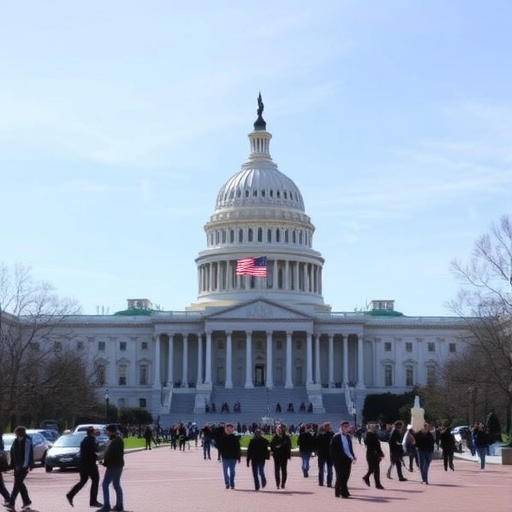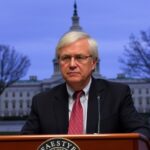Speaker Johnson Issues Stark Warning on Shutdown’s Historic Proportions
As the Government shutdown stretches into its 20th day, House Speaker Mike Johnson has issued a grim prediction that this impasse could etch itself into history books as the longest federal closure on record. Speaking to reporters on Capitol Hill, Johnson lamented the stalled negotiations between Republicans and Democrats, pinning the blame squarely on partisan divides over healthcare cuts. “We’re on the brink of a shutdown that surpasses even the 35-day ordeal of 2018-2019,” Johnson warned, his voice carrying the weight of frustration after yet another fruitless session in Congress. This shutdown, triggered by disagreements in a must-pass spending bill, has already furloughed over 2 million federal workers and halted non-essential services across the nation.
- Speaker Johnson Issues Stark Warning on Shutdown’s Historic Proportions
- Democrats Rally Against Proposed Healthcare Reductions
- Public Polls Reflect Bipartisan Frustration with Congressional Impasse
- Economic and Social Ripples from the Extended Government Closure
- Prospects for Resolution in Fractured Bipartisan Talks
The roots of this crisis trace back to December 15, when funding lapsed amid Republican insistence on deeper budget trims, including significant reductions to health programs. Democrats, led by Senate Majority Leader Chuck Schumer, have vowed not to yield, demanding full restoration of funding for initiatives like the Affordable Care Act subsidies and Medicaid expansions. Johnson’s comments come at a pivotal moment, as the holiday season amplifies the human cost, with families facing delayed benefits and essential services grinding to a halt. Polling data from Gallup, released just yesterday, underscores the public’s growing exasperation, with 52% of Americans now viewing the Government shutdown as a failure of leadership from both sides.
Behind the scenes, Congress insiders reveal that closed-door talks have devolved into finger-pointing marathons. One anonymous GOP aide described the atmosphere as “toxic,” with little progress on bridging the $20 billion gap in proposed healthcare cuts. Johnson’s prediction isn’t hyperbole; historical precedents like the 1995-1996 shutdowns, which lasted 21 and 16 days respectively, pale in comparison to the potential trajectory here. If unresolved by early January, this could disrupt everything from national park operations to IRS tax refund processing, compounding economic strain estimated at $1.5 billion per week by the Congressional Budget Office.
Democrats Rally Against Proposed Healthcare Reductions
At the heart of the deadlock lies a fierce battle over healthcare cuts, with Democrats framing the Republican proposals as an assault on vulnerable populations. The GOP’s budget blueprint includes slashing $150 billion from federal health expenditures over the next decade, targeting areas like preventive care under Obamacare and rural hospital funding. Senate Democrats, in a floor speech yesterday, decried these measures as “cruel and shortsighted,” with Schumer invoking stories of constituents who rely on these programs to survive chronic illnesses.
“We will not stand by while millions lose access to affordable insurance,” Schumer thundered, echoing demands from progressive lawmakers like Alexandria Ocasio-Cortez, who has mobilized social media campaigns highlighting personal testimonies from affected families. One such story comes from Maria Gonzalez, a single mother in Ohio whose child’s asthma treatments are subsidized through Medicaid expansions now under threat. “This shutdown isn’t just politics; it’s putting lives at risk,” Gonzalez shared in a viral video that’s garnered over 500,000 views.
Republican defenders, including Johnson, argue that these healthcare cuts are essential for fiscal responsibility, pointing to rising national debt exceeding $34 trillion. “We’re not cutting care; we’re cutting waste,” Johnson asserted during a Fox News interview, citing inefficiencies in the Centers for Medicare & Medicaid Services. Yet, experts from the Kaiser Family Foundation dispute this, estimating that the cuts could lead to 2.3 million Americans losing coverage by 2025, disproportionately impacting low-income and minority communities. Negotiations in Congress have seen Democrats propose counteroffers, including phased restorations tied to economic growth metrics, but these have been rebuffed by hardline conservatives demanding immediate austerity.
The partisan rift has historical echoes; similar disputes derailed budget talks in 2013, leading to a 16-day shutdown. This time, with midterms looming, both parties are digging in, wary of appearing weak. Bipartisan groups like the Problem Solvers Caucus have floated compromise bills restoring 80% of health funding in exchange for minor tax reforms, but these remain sidelined in the hyper-polarized chamber.
Public Polls Reflect Bipartisan Frustration with Congressional Impasse
Fresh polls paint a picture of widespread disillusionment, with Americans evenly splitting blame between Republicans and Democrats for the protracted Government shutdown. A Pew Research Center survey conducted over the weekend found that 48% of respondents fault both parties equally, a stark rise from 35% at the shutdown’s onset. Independents, who make up 40% of the electorate, are particularly incensed, with 62% disapproving of Congress‘s handling of the crisis.
“The American people are tired of this Washington theater,” said pollster Frank Luntz in an NPR analysis, noting that approval ratings for Speaker Johnson have dipped to 28%, while Schumer’s hovers at 32%. Urban voters, hit hardest by delayed Social Security payments and food assistance programs, express the most outrage; in cities like Detroit and Los Angeles, local protests have drawn hundreds demanding an end to the stalemate. One demonstrator, retired veteran Tom Reilly, held a sign reading “Fix Healthcare, Not Your Image,” capturing the sentiment that healthcare cuts are exacerbating everyday hardships.
Economists warn that this public backlash could influence 2024 electoral dynamics. A Quinnipiac poll ties the shutdown to broader concerns, with 55% of voters prioritizing healthcare access over deficit reduction. Social media amplifies these voices, with hashtags like #EndTheShutdown and #SaveHealthcare trending globally, amassing 1.2 million posts. Even international observers, from the BBC to Al Jazeera, are covering the story, questioning U.S. governance stability amid the chaos.
Within Congress, the polls are fueling internal pressures. Moderate Republicans like Sen. Susan Collins have urged Speaker Johnson to reconsider hardline stances, while Democratic leadership uses the data to rally base support. Yet, as negotiations drag on, the risk of voter fatigue looms, potentially leading to record-low turnout if the shutdown persists.
Economic and Social Ripples from the Extended Government Closure
Beyond the Beltway, the government shutdown is unleashing tangible hardships, from shuttered federal agencies to strained state budgets absorbing the fallout. The Department of Health and Human Services, for instance, has paused routine inspections of nursing homes, raising alarms about patient safety in an already overburdened system. Small businesses dependent on government contracts report losses exceeding $500 million, according to the U.S. Chamber of Commerce, with sectors like defense and agriculture feeling the pinch most acutely.
Personal narratives underscore the human toll. In Virginia, federal employee Lisa Tran, furloughed from her role at the National Institutes of Health, shared with The Washington Post how she’s rationing groceries to make ends meet. “Healthcare cuts were bad enough on paper; now the shutdown makes it real,” Tran said, her story resonating with thousands facing similar dilemmas. Unemployment claims have spiked 15% in shutdown-affected areas, per Labor Department data, while food banks report a 20% uptick in demand.
On the economic front, Moody’s Analytics projects a 0.2% GDP hit if the shutdown reaches 30 days, potentially shaving $18 billion from quarterly growth. Stock markets have reacted nervously, with the Dow dipping 1.5% last week on fears of prolonged uncertainty. Internationally, allies like Canada and the EU express concern over delayed trade deals and diplomatic engagements, as embassies operate on skeleton staffs.
Congress‘s inaction also exacerbates inequality; rural communities, reliant on USDA farm subsidies now frozen, face harvest delays that could cost $2 billion in spoiled produce. Environmental monitoring by the EPA has halted, allowing potential polluters unchecked leeway. These ripples highlight how negotiations failures cascade into real-world crises, pressuring lawmakers to act before irreversible damage sets in.
Prospects for Resolution in Fractured Bipartisan Talks
Looking ahead, the path out of this government shutdown remains murky, with Speaker Johnson scheduling emergency negotiations for later this week, though skepticism abounds. Bipartisan mediators, including former Senate leaders, have offered to facilitate talks, proposing a short-term funding extension to buy time for comprehensive reforms. However, conservative factions within the GOP, emboldened by Johnson’s leadership, insist on locking in healthcare cuts before any truce.
Analysts from the Brookings Institution suggest a breakthrough could hinge on external pressures, such as bond market volatility or veteran-led advocacy groups lobbying Capitol Hill. President Biden, in a White House address, called for “common-sense compromise,” hinting at executive actions to mitigate health impacts if Congress stalls further. Yet, legal experts caution that such moves could spark constitutional clashes.
If history is a guide, resolutions often come at the eleventh hour; the 2018 shutdown ended after 35 days with a deal averting deeper cuts. This time, with polls showing eroding support, both parties may concede ground—Democrats on minor spending caps, Republicans on health protections. Watch for key votes in the coming days, as the nation braces for potential escalation or, hopefully, de-escalation in this high-stakes drama.
Stakeholders from healthcare advocates to business leaders urge swift action, emphasizing that prolonged deadlock erodes trust in democratic institutions. As Day 21 dawns, the stakes couldn’t be higher: a record-breaking shutdown or a fragile peace restoring vital services and healthcare safeguards.









